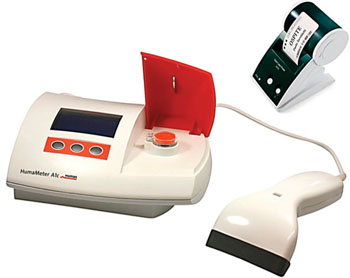Blood Test Uncovers Undiagnosed Diabetes In Hospital Patients
By LabMedica International staff writers
Posted on 09 Jun 2016
Hyperglycemia is a frequent finding that can be related to physiologic stress, illness and medications, including steroids and vasopressors and glycated hemoglobin (HbA1c) correlates with the average blood glucose level over the previous eight to 12 weeks.Posted on 09 Jun 2016
Screening of HbA1c levels plays an important role in the diagnosis and management of diabetes mellitus in the outpatient setting but remains underused in the evaluation of hyperglycemia with undiagnosed diabetes in the inpatient setting.

Image: A point-of-care glycated hemoglobin (HbA1C) analyzer (Photo courtesy of HUMAN Diagnostics).
Scientists from the Touro University California (Vallejo, CA, USA) and the Heritage College of Osteopathic Medicine (Athens OH, USA) reviewed the medical records of 348 patients with hyperglycemia inpatients discovered at admission in a rural community teaching hospital from June 31, 2012, to July 1, 2014. Of those patients, 50 had no known history of diabetes and 31 of them were given an HbA1C test, which measured the average blood glucose level over the previous two to three months.
Fifty patients treated for hyperglycemia had medical records with no known history of diabetes (NKHD). Of the 50 patients with NKHD, 31 (62%) had an HbA1c test. Of the 31 patients tested, 6 (19%) had HbA1c levels consistent with the diagnosis of prediabetes, and 18 (58%) had levels consistent with diabetes. Seventeen (55%) of the 31 patients had a discharge diagnosis that included diabetes. Of the 19 patients with NKHD who did not have an HbA1c test, 2 (11%) received a discharge diagnosis that included diabetes. The 50 patients with NKHD had a 50% longer mean hospital stay compared with the 298 patients with known diabetes.
Jay H. Shubrook, DO, the senior author of the study, said, “The study shows us that we are missing opportunities to detect diabetes and initiate treatment for those patients to help manage that disease, which can reduce their long-term cost of care and disease burden. From the osteopathic perspective of early detection equals better outcomes, it's easy to make a case for hospital protocols to trigger an HbA1C test when hyperglycemia is detected to distinguish between transient hyperglycemia and chronic disease.” The study was published in the June 2016 issue of The Journal of the American Osteopathic Association.
Related Links:
Touro University California
Heritage College of Osteopathic Medicine














